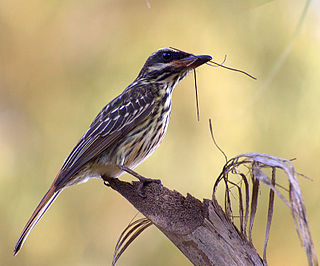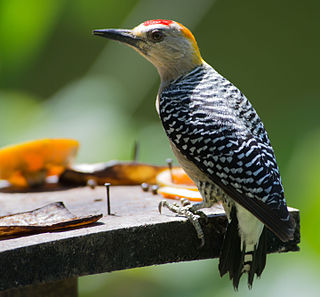
The New World warblers or wood-warblers are a group of small, often colorful, passerine birds that make up the family Parulidae and are restricted to the New World. The family contains 120 species. They are not closely related to Old World warblers or Australian warblers. Most are arboreal, but some, like the ovenbird and the two waterthrushes, are primarily terrestrial. Most members of this family are insectivores.

The cinnamon teal is a species of duck found in western North and South America. It is a small dabbling duck, with bright reddish plumage on the male and duller brown plumage on the female. It lives in marshes and ponds, and feeds mostly on plants.

The sooty tern is a seabird in the family Laridae. It is a bird of the tropical oceans, returning to land only to breed on islands throughout the equatorial zone.

The northern parula is a small New World warbler. It breeds in eastern North America from southern Canada to Florida.

The bluish-grey saltator or Amazonian grey saltator is a passerine bird in the tanager family Thraupidae that is widespread in semi-open habitats in tropical and subtropical South America.

The yellow-throated warbler is a small migratory songbird species in the New World warbler family (Parulidae) found in temperate North America.

Socorro Island is a volcanic island in the Revillagigedo Islands, a Mexican possession lying 600 kilometres (370 mi) off the country's western coast. The size is 16.5 by 11.5 km, with an area of 132 km2 (51 sq mi). It is the largest of the four islands of the Revillagigedo Archipelago. The last eruption was in 1993.

Andrew Jackson Grayson (1819–1869) was an American ornithologist and artist.

The Socorro mockingbird is an endangered mockingbird endemic to Socorro Island in Mexico's Revillagigedo Islands. The specific epithet commemorates the American ornithologist Andrew Jackson Grayson.

The tropical mockingbird is a resident breeding bird from southern Mexico to northern and eastern South America and in the Lesser Antilles and other Caribbean islands.

The red-crowned ant tanager is a medium-sized passerine bird from tropical America. It is the only species now placed in the genus Habia. This species was long placed with the tanagers (Thraupidae), but it is actually closer to the cardinals (Cardinalidae).

The streaked xenops is a passerine bird in the Furnariinae subfamily of the ovenbird family Furnariidae. It is found in the New World from Costa Rica and Trinidad south to Bolivia and Argentina.

The streaked flycatcher is a passerine bird in the tyrant flycatcher family.

The white-throated spadebill is a tiny passerine bird in the tyrant flycatcher family. It lives in the tropical Americas.

Parula was formerly a small genus of New World warblers which breed in North and South America.

The red-lored amazon or red-lored parrot is a species of amazon parrot, native to tropical regions of the Americas, from eastern Mexico south to Ecuador where it occurs in humid evergreen to semi-deciduous forests up to 1,100 m altitude. It is absent from the Pacific side of Central America north of Costa Rica. Not originally known from El Salvador, a pair - perhaps escaped from captivity - nested successfully in 1995 and 1996 in the outskirts of San Salvador and the species might expand its range permanently into that country in the future. This species has also established feral populations in several California cities.

The squirrel cuckoo is a large and active species of cuckoo found in wooded habitats from northwestern Mexico to northern Argentina and Uruguay, and on Trinidad. Some authorities have split off the western Mexican form as the Mexican squirrel-cuckoo.

Hoffmann's woodpecker is a species of bird in subfamily Picinae of the woodpecker family Picidae. It is found from Honduras south to Costa Rica.

The wedge-billed woodcreeper is a sub-oscine passerine bird in subfamily Dendrocolaptinae of the ovenbird family Furnariidae. It is found in Mexico, Central America, Brazil, Bolivia, Ecuador, French Guiana, Guyana, Peru, Suriname, and Venezuela.

The variable seedeater is a passerine bird which breeds from southern Mexico through Central America to the Chocó of northwestern South America. The taxonomy is confusing, and it was formerly considered a subspecies of Sporophila americana. Even within the variable seedeater as presently defined, there are great variations in plumage.























